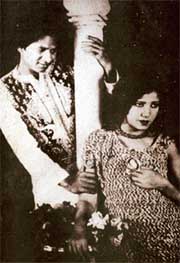Master Vithal
Master Vithal | |
|---|---|
 | |
| Born | 1906 |
| Died | 1969 (aged 62–63) |
| Occupation | actor |

Master Vithal or Vithal (1906-1969) was an actor in Indian cinema, best known as the hero of India's first talkie Alam Ara (1931) and of Marathi and Hindi silent stunt films (silent films had cue cards in a particular language), which gave him the epithet as the Douglas Fairbanks of India.
Vithal started his film career in Marathi films in 1924 and worked as a film technician and dancer. He was cast as the male lead in Ratan Manjari (1926) and followed with the swashbuckling roles of many silent stunt films and became a very popular actor. Though he was the male lead of Alam Ara, he hardly had any dialogue due to poor Hindi diction. He returned to silent films and then to talkie Marathi films from 1932 till his last film in 1966. He also directed two films and gave music score to one film. He acted in more than 90 films during his career of 42 years from 1924 to 1966.[1]
Pre 1930 career
Master Vithal's début was on the stage as a child artist with Raja Pur Ka Natak Mandali. He then started his career as a film editor with the film company in Maharashtra Films, Kolhapur which was owned by Baburao Painter. His first film role was as a female dancer in Kalyan Khajina, the silent era film directed by Painter. He continued to work as film editor and a dancer and played minor roles in films. His first break as a male lead was in the film Ratan Manjari (1926) produced by Sharda Studios whom he had joined earlier in 1925. After that, he was a permanent fixture in the role of a hero and he was the star attraction of the Sharda Studios, owned by Nanubhai Desai, Anand Prasad Kapoor and Harshadrai Mehta. Nanubhai Desai was the studio founder and director of many stunt films produced by the company in which Vithal appeared in swashbuckling roles with Zebunissa as his heroine. A professional wrestler,[2] he became a very popular fearless hero acting in films in historical themes related to Rajasthan and Maharashtra; thus giving him the title "the Indian Douglas Fairbanks", a title Vithal hated.[3] Audience adored him in his stunt hero role, which became his "forte".[4] By 1930, he was the highest paid male star in Indian cinema industry.[5]
Post 1930 career
In 1930, Vithal's popularity in Marathi films attracted
In 1933, Master Vithal introduced the concept of double role in Hindi talkie cinema by his directorial début Raja (in Marathi) and Awara Shahzada (Hindi), in which the role of a prince and a pauper was played by Shahu Modak, whereas Vithal played his first double role in the silent film Raj Tarang (1928).[5][9]
Films
Master Vithal acted in more than 90 films, directed two films (Swarajyacha Shiledar and Awara Shahzada), and composed music for only one film, (Kashmir Ki Kali). The list of his movies, in the descending order of their release, has the following names.[1]
- Sheras Savva Sher (1966)
- Shodha Mhanje Sapdel (1966)
- Sadhi Manse (1965)
- Vavtal (1965)
- Mohityanchi Manjula (1963)
- Vanakesari (1960)
- Akashganga (1959)
- Matevin Bal (1958)
- Naikinicha Sazza (1957)
- Pavankhind (1956)
- Tai Teleen (1953)
- Vaadal (1953)
- Chhatrapati Shivaji (1952)
- Mard Maratha (1952)
- Mayecha Pazhar (1952)
- Narveer Tanaji (1952)
- Swarajyacha Shiledar (1951)
- Shilanganache Sone (1950)
- Vikram Shashikala (1949)
- Garibanche Rajya (1948)
- Jai Bhawani (1947)
- Jadugar (1946)
- Kashmir Ki Kali (1946)
- Rukmini Swayamvar (1946)
- Sasurvaas (1946)
- Nagma-E-Sahra (1945)
- Pannadai (1945)
- Ramshastri(1944)
- Bahirji Naik (1943)
- Soonbai (1942)
- Amrit Vilas (1941)
- Jagat Mohini (1940)
- Mohini (1940)
- Netaji Palkar (1939)
- Asiai Sitara (1937)
- Hind Mahila (1936)
- Raj Tarang (1935)
- Rangila Nawab (1935)
- Bhedi Rajkumar (1934)
- Chhatrapati Sambhaji (1934)
- Burkhewala (1932)
- Kalo Bhoot (1932)
- Zalim Jawani (1932) as Pratap
- Alam Ara (1931) as Adil
- Anangsena (1931)
- Daulat Ka Nasha (1931)
- Dilawar (1931)
- Gulam (1931)
- Hoor-E-Misar (1931)
- Meri Jaan (1931)
- Arunodaya (1930)
- Dav Pech (1930)
- Josh-E-Jawani (1930)
- Veer Na Ver (1930)
- Bhedi Sawar (1929)
- Chirage Kohistan (1929)
- Mirza Sahiban (1929)
- Nishan Danka (1929)
- Ranghelo Rajput (1929)
- Rank Nu Ratan (1929)
- Gul Badan (1928)
- Heer Sundari (1928)
- Kanak Kanta (1928)
- Karuna Kumari (1928)
- Raj Tarang (1928)
- Sassi Punnu (1928)
- Saundarya Sura(1928)
- Sohni Mahiwal (1927/II)
- Asuri Lalsa (1927)
- Balidan (1927)
- Bansari Bala (1927)
- Bhedi Trishul (1927)
- Jaan-e-alam Anjuman Ara (1927)
- Kala Pahad
- Mahasati Ansuya
- Shiraz-Ud-Dowla (1927)
- Swadesh Seva (1927)
- Vande Mataram Ashram (1927)
- Veer Garjana (1927)
- Gunial Gulab (1926)
- Madan Kala (1926)
- Ratan Manjari (1926)
- Suvarna Kamal (1926)
- Vasant Bala (1926)
- Bajirao Mastani (1925)
- Kalyan Khajina (1924) as a dancing girl
References
- ^ a b c "Master Vithal (?–1969)". CITWF. Retrieved 7 April 2013.
- ISBN 978-0-7619-3320-5. Retrieved 7 April 2013.
- ISBN 978-0-8223-5213-6. Retrieved 7 April 2013.
- ^ a b c "Silent Screen Stars". Master Vithal (-1969). A Living Portrait -India Heritage Organization. Retrieved 7 April 2013.
- ^ ISBN 978-81-7991-066-5. Retrieved 7 April 2013.
- ^ a b c "Master Vithal (d. 1969)". Cineplot.com. Retrieved 7 April 2013.
- ^ a b "The Ghost Who Talked". Outlook Online.com. 4 June 2012. Retrieved 7 April 2013.
{{cite journal}}: Cite journal requires|journal=(help) - ISBN 978-81-230-0646-8. Retrieved 7 April 2013.
- ^ Sanjit Narwekar; Raghuvir Kul; D. B. Samant (1995). Marathi Cinema: in retrospect. Maharashtra Film, Stage & Cultural Development Corp. p. 52. Retrieved 7 April 2013.
